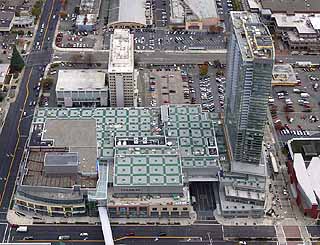|
Subscribe / Renew |
|
|
Contact Us |
|
| ► Subscribe to our Free Weekly Newsletter | |
| home | Welcome, sign in or click here to subscribe. | login |
Construction
| |
 |
December 1, 2005
Solving the puzzle of Lincoln Square
Skanska USA Building

Harrison
|

Young
|
In fact, the huge, multi-faceted project has required Skanska USA Building to take a highly customized management approach to complete Lincoln Square's retail and hotel space this past month, and stay on track to deliver 148 luxury condo units in April of 2006.
The local general contractor, in collaboration with Lincoln Square's owner, set in place a number of management strategies that were executed starting when Kemper Development Co. first considered purchasing the site. Previous owners had stalled in their attempts to build the downtown Bellevue complex.
Managing construction
Skanska developed a comprehensive system to plan and build the residential and commercial project, which required more than 5,500 tons of structural steel for the retail area alone.
The management approach had to be unique for many reasons, not the least of which was the sheer size and complexity of the project. Lincoln Square's architectural intent had changed dramatically since its previous owners stopped development, and that added to the complexity, along with the fact that the foundation was poured and initial steel and concrete construction had started on the first few floors.

Photo by Soundview Aerial Photography
Skanska assigned separate teams of office and field workers to each component of Lincoln Square, including the garage, retail, hotel and condos. The system was put in place to keep the project on schedule.
|
Creating a construction-management system to help determine the project's feasibility was a critical first step. Perhaps more important, though, it needed to be created in a way that enabled Skanska to execute Lincoln Square's complicated development plan without slowing progress — or raising costs — during an aggressive construction cycle.
Skanska had to staff its team with a greater number of managers and a more specialized group of builders than necessary for a more typical construction project. So some six months before Kemper Development had even agreed to buy the project, Skanska established teams of field and office professionals that would remain in place from the conceptual-development days until now.
A $3.5M retrofit
The first order of business was to research the project from both a financial and logistical perspective, and find a way to develop it in a cost-effective, timely manner.
A team led by several project supervisors and staffed by iron workers, concrete specialists and other construction field people investigated the site. They looked at whether the project had been constructed properly, and if elements such as anchor bolts would accept the tons of structural steel that had been stored for months in Oregon and Canada.
Much of the design vision had changed, so the field team consulted daily with the Skanska office-management team to decide how the existing structure might need to be retrofitted. It ultimately underwent $3.5 million in renovations for a more functional, user-friendly parking garage.
After due diligence was completed and the project officially purchased, Skanska organized pre-construction activities around a number of critical elements such as pricing, value engineering and site evaluations. These tasks were executed for six months, before any concrete or steel was purchased and while architects continued to refine the drawings.
Unconventional choice
Once actual construction began in early summer 2004, Skanska instituted another unconventional layer to its system. It created teams of office and field workers specifically for each product type. A separate set of project supervisors and managers would be solely responsible for construction of the garage, while other building teams would oversee work on retail, the hotel and the condos.
The idea was that by limiting their focus, the teams could concentrate and avoid getting sidetracked on another type of product. This meant Skanska was able to keep the project on time and under budget while maintaining varying levels of quality for finishings in each area.
There has been some limited overlap in Lincoln Square's construction activities, including the creation of a single curtain wall team. But on the whole, Skanska collaborated with its numerous subcontractors to organize teams according to each component throughout the complex building cycle. Coordinating construction in any other way would likely have put sheet-rockers, concrete workers and other team members behind schedule, put the project over budget and unnecessarily pushed back the completion of the hotel tower.
In addition, Skanska also charged a single person with scheduling and tracking every one of the more than 12,000 deliveries on the project site. By eliminating the need for project supervisors to arrange their own deliveries, no street-use permits were required to be purchased by the owner, and workers avoided costly interruptions caused by trucks waiting for cranes or access to other drop-off areas at the site.
Dave Harrison is an account manager and leader of the Lincoln Square office team for Skanska. Frank Young is a senior superintendent and commander of Skanska's Lincoln Square field team.
Other Stories:


